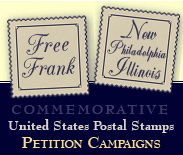History of Free Frank: Chapter Six: Black Pathfinders on the Illinois Frontier
Copyrighted Material
Land Acquisitions and New Philadelphia's Origin
| Be it Remembered that before me Jonathan Piper a justice of the peace within and for said county and State Free Frank a collered man the proprietor of a new Town named Philadelphia ... in the County of Pike and State of Illinois and who is personally Known to me to be the identical person who Claims the same as proprietor and acknowledged the within and foregoing to be a true and perfect plat of said Town delivered hand and seal of Pittsfield the 16th day of September in the year 1836.' |
The town of New Philadelphia was platted on an eighty-acre tract that Free Frank had purchased from the federal government for $100 in 1835.2 While this tract was the first of eight that Free Frank and his sons would buy within the next four years, the town's site was the only land purchase made that year. Solomon's manumission from slavery had been Free Frank's paramount objective. With that accomplished, and with both Young Frank and Solomon working the family's farm, Free Frank intensified the cultivation of their 160-acre farm holdings. In the following year, with money earned from the sale of farm produce and livestock, he acquired five additional tracts amounting to 280 acres. Four of those tracts were purchased from the federal government, a total of 200 acres for $250. The other tract involved a private land purchase of 80 acres for $112, twelve dollars more than what the land would have cost at a minimum if purchased from the federal government. In this instance the site's location, adjacent to the tract purchased in 1835, was important to Free Frank. Its acquisition allowed him to consolidate his holdings. The last two tracts, a total of 280 acres purchased during a depression also involved private transactions. One of these was a 120-acre tract purchased by Free Frank's son Commodore in 1839 for $900. Over a decade passed before final payment was made, in 1852…
Federal lands laws controlled the purchase of those tracts that Free Frank acquired from the federal government.5 Under the Land Act of 1820, the federal government had for the first time allowed a minimum eighty-acre acquisition but also required full payment at the time of purchase. After 1835 Free Frank's land was purchased under the 1832 Land Act, made effective in the Illinois Military Tract when public land in this area was put on sale in 1834. While this act allowed a minimum purchase of forty-acre tracts, under the 1836 Land Act the federal government required full payment in specie for public land. Private land offices, quickly established in frontier areas, provided loans, but interest rates, which ran as high as 37 percent, discouraged some prospective buyers. Until the full amount was paid, the office controlled title to the land, and payment default often resulted in the farmer's loss of property and any improvements, as well. Table 6 shows a total of 800 acres in Hadley township purchased by Free Frank and his sons from 1830 through 1839. The location of each tract is shown in Figure 5, a federal surveyor's map of Hadley township…
The government surveyor who drew the map of Hadley township gave the following description of the land purchased by Free Frank and his sons: “Between Sections 26 and 27 T4SR5W there was a creek. Sections 22, 23, 26, and 27, brook running through over Broken Bushy Barrens. Timber oak, undergrowth oak and hazel.” E. Dana, a private citizen who traveled through the Military Tract in 1819 to secure information for distribution to prospective settlers, also described Hadley township: “Range 5—sees. 16, 17, 18, 19, 20, 21, 22, 28, 29, 30, 31, 32, 33, 34, west half of 15, 2, 3, 36, first rate; sees. 24, 10, 5, 6, 7, north half of 8, 9, second rate; remainder mostly much broken: growth oak, hickory, ash, lynn, grape and pea vines…”5
By 1836, in addition to platting a town, Free Frank owned 600 acres of land. As a free black his right to the ownership of his property under Illinois law was somewhat limited. It was at best a specious right emanating from property rights granted blacks who had been indentured servants.31 But Free Frank's land-purchasing activities in Kentucky and the court cases in which he had been involved in that state had demonstrated to him that in some in-stances American law could be used to the advantage of blacks. In 1836, using as a precedent the Illinois law that permitted manumitted blacks to own property, Free Frank petitioned the Illinois General Assembly for the right to take a legal surname so that title to his property would not be alienated. The surname requested in the petition was McWorter.32
|

